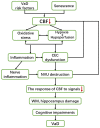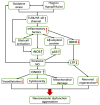The Roles of Nitric Oxide Synthase/Nitric Oxide Pathway in the Pathology of Vascular Dementia and Related Therapeutic Approaches
- PMID: 33926146
- PMCID: PMC8123648
- DOI: 10.3390/ijms22094540
The Roles of Nitric Oxide Synthase/Nitric Oxide Pathway in the Pathology of Vascular Dementia and Related Therapeutic Approaches
Abstract
Vascular dementia (VaD) is the second most common form of dementia worldwide. It is caused by cerebrovascular disease, and patients often show severe impairments of advanced cognitive abilities. Nitric oxide synthase (NOS) and nitric oxide (NO) play vital roles in the pathogenesis of VaD. The functions of NO are determined by its concentration and bioavailability, which are regulated by NOS activity. The activities of different NOS subtypes in the brain are partitioned. Pathologically, endothelial NOS is inactivated, which causes insufficient NO production and aggravates oxidative stress before inducing cerebrovascular endothelial dysfunction, while neuronal NOS is overactive and can produce excessive NO to cause neurotoxicity. Meanwhile, inflammation stimulates the massive expression of inducible NOS, which also produces excessive NO and then induces neuroinflammation. The vicious circle of these kinds of damage having impacts on each other finally leads to VaD. This review summarizes the roles of the NOS/NO pathway in the pathology of VaD and also proposes some potential therapeutic methods that target this pathway in the hope of inspiring novel ideas for VaD therapeutic approaches.
Keywords: nitric oxide; nitric oxide synthase; pathology; therapeutic approaches; vascular dementia.
Conflict of interest statement
The authors declare no conflict of interest.
Figures





References
Publication types
MeSH terms
Substances
Grants and funding
LinkOut - more resources
Full Text Sources

